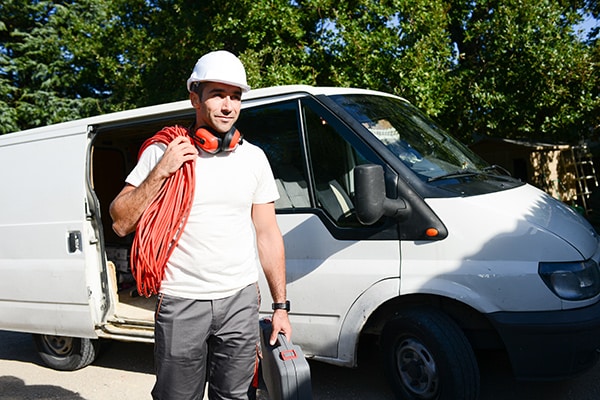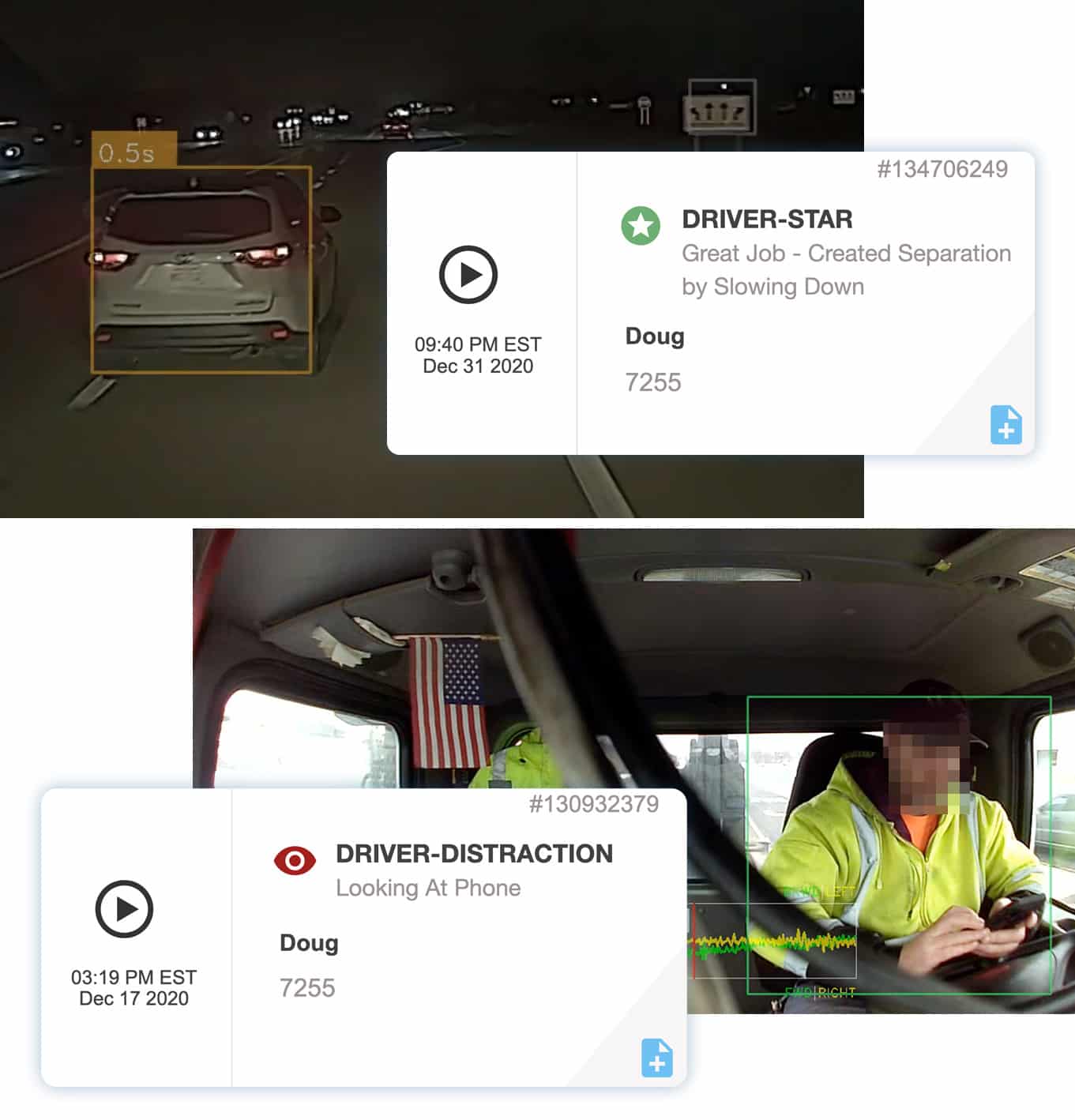
10 Critical Tips for Using Dash Cams.
Many organizations are poised to fall into a trap with using dash cams – they’ll invest significant time and resources into procuring, installing, and launching a dashcam-based driver safety initiative.
They’ll benchmark their drivers, coach them to improve, hit their goals … and then ease off. Safety scores will plummet because they think they have a “set it and forget it” solution.
We’ve seen this happen. If you have the right dash cam and right policies, though, it’s completely avoidable. The 10 tips in this article will ensure sustained success for your organization, vehicles, and drivers.
One caveat, though – and we admit it’s a big one: These tips will only work with some smart dash cams equipped with Artificial Intelligence. This all assumes that your camera equips you with true visibility to see what your drivers are doing right, not just what they’re doing wrong. And yes, there are cameras that can do this!
Policies and Preparation for Dash Cam Success
You’ll need to build a foundation to ensure your success using dash cams. Here are some tips that can help you roll this new aspect of your safety program out to the people it will affect. Following these steps can improve your odds of employee buy-in.
1. Remember, Driving is Only Part of the Job
Even in commercial fleets, very few people have a role that’s exclusively driving. For most, driving is simply the way to get to the customers or the job site. You have technicians, plumbers, maintenance workers, sanitation workers – none of whom think of themselves as “drivers.”
They’re thinking more about the job they need to perform than they might be about the driving. Using a dash cam should be a way to help them drive better.
Drivers shouldn’t have to think about turning it on or off. They should be able to easily see summaries of their activity during their downtime. It’s even better if they have the convenience of an app on their mobile device to find what they need.
This prevents driving and using a dash cam from interfering with their actual job. But you’ll still work together to develop safer driving habits that also reduce your organization’s risk.

2. Establish a Camera Use Policy
Many organizations know that employees are worried about dash cams. That’s reasonable. They’re worried that you’ll watch them every minute or use it as an excuse to fire them.
This is an opportunity to make the point that you’ll use dash cams to coach employees, not fire them. Show what behaviors will trigger an alert and the process for dealing with them. Also outline who will be allowed access to the footage and how long you’ll keep it.
By setting these guardrails, you’ll put employees more at ease with using dash cams. Be sure to show who will be watching footage and when. Make it clear that the tool is not designed for, nor do you have the time to sit and spy on them on the road.
Need some help with writing a policy? We have you covered with these tips and a downloadable template.
3. Show What Your Camera Can Do
If you’ve gone all-in on using dash cams, you’ll likely wind up with one powered by artificial intelligence. Some of these cameras can show good driving actions as well as unsafe choices. Show employees how the footage and scoring system can be used to recognize good, bad, and moderate driving.
It’s also smart to show how the camera can add context to insights from your GPS tracking data. A typical GPS tracker can show that a driver made a hard stop, which could look bad taken out of context.
Using a dash cam can add context to that event by showing the hard stop was your employee taking action to avoid a crash.
4. Create an Incentive Program
Sure, good work is its own reward. But it’s even better to get some concrete recognition for it.
Organizations with the most-successful safety programs have something in common. And that’s an incentive program.
Awarding your safest drivers with a gift card or time off provides a reason for employees to go the extra mile to improve their driving. Getting the driver to actively monitor their score is the best way to scale safety improvements quickly. You can still get good results without an incentive program. But this is a way to show that you’re committed to safety. It provides a regular goal that will stay in employees’ minds every time they’re behind the wheel.
It also helps to show where leaders are scoring. That can show other employees what they need to do to reach the top!

5. Empower Your Employees
It’s tempting to let your AI-powered camera do all the work and view it as a “zero tolerance” tool.
That would be a mistake. Instead, be sure employees are empowered. They should be able to see what footage the camera identifies as unsafe and be allowed to contest it.
At this point, false positives are still an issue with any camera. We’ve heard of footage being tagged as unsafe because a driver touched his beard (distracted driving), sang along with the radio (drowsy driving), and wore a shirt the same color as their seatbelt (seatbelt use violation).
That makes it imperative for drivers to have access to the footage and be able to easily provide feedback to their supervisors.
6. Coach Automatically and In-Person
We’ve established that a capable AI dash cam solution opens a number of possibilities. Think of how that translates into a tiered coaching program.
For example, you could identify the first level as in-cab alerts that provide a friendly warning to drivers; if they correct the unsafe behavior quickly enough, they won’t trigger a notification. That’s self-coaching in real-time.
A further level of self-coaching is being able to verify whether employees are reviewing footage tagged as unsafe. This is an effective way to keep safe driving top-of-mind for your employees.
The third level is in-person coaching. This might require more time, so it’s best to reserve the option for drivers who have a pattern of risky behavior.
Keeping this framework in mind can show you how effectively the AI is streamlining your coaching. In-person coaching should be rare in this model.
7. Be Consistent With Your Standards
Larger organizations with multiple locations might think about setting their camera alert thresholds differently. For example, Location A might want to alert managers if a driver goes more than 7mph above the speed limit. Location B in the next state might think 13mph is better for them.
Establishing different thresholds is a bad idea.
That makes it impossible to judge all drivers by the same standards. If you want long-term success using a dashcam, you need to set your configurations the same for your entire company. That allows a level playing field for all employees.
Once you have effective policies, it’s time to focus on what you’ll do with the insights you get from the cameras. Consistency is key – once you have your dash cam safety program going, you need to stick with it.
8. Keep Careful Records of Scoring
Fast forward a year or two. Your organization is, from management to the drivers, comfortable with dash cams.
Maybe too comfortable, because bad old habits are starting to creep back in. What happens if you want to know how you compare to those early days when your fleet’s safety scores increased?
It’s wise to make sure you keep monthly records for your fleetwide safety averages. That way, you can easily reference data going back months and years without relying on our solution to provide that data.
If you want to go the extra mile, you should also think about preserving individual monthly scores.
9. Share a Weekly Example of Good Driving
Chances are, your drivers spend most of their time obeying the speed limit, allowing other drivers to merge, leaving the proper amount of space from other vehicles, and numerous other small actions that make them safe and courteous.
Find examples of these actions every week and share them with employees. It’s a great way to reinforce that dash cams are here to help – remember, coaching also means reinforcing positive behaviors rather than simply focusing on unsafe driving.
Admittedly, this can be a time-consuming activity if you have to search through footage hoping to uncover examples of safe driving. There are cameras like Driveri that can do this automatically, saving you time in your effort to coach your drivers.
10. Continue Coaching Even After Improvement
When you see your safety scores rise, it’s tempting to think that you’ve solved the problem of dangerous driving.
We get it. There’s so much on your plate, and every moment counts.
But if you want your safety scores to stay consistently high, you need to make coaching part of your organizational culture.
One easy way is to schedule a brief conversation with each driver at regular intervals. That sends the message that your dashcam safety initiative is still a priority. It also carries more weight than simply relying on drivers to coach themselves using an app. Of course, apps are a great tool – but you should also plan to have conversations with your drivers.
Final Thoughts on Long-Term Success Using Dash Cams
Stop us if you’ve heard this line before: Safety is no accident.
We admit that it’s tough to remain vigilant day after day, month after month. That’s especially true after a period of improvement (just ask someone in April after they make a New Years resolution to go to the gym more).
So plan ahead and be mindful of these tips. They’ll help you avoid the post-success slump.





